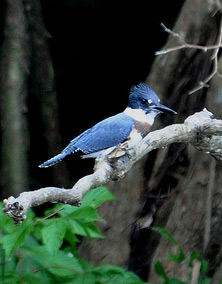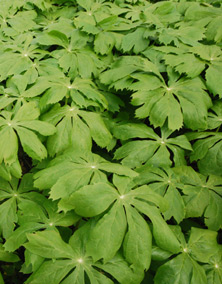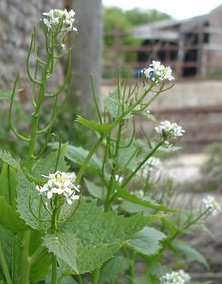Plants and Wildlife
Mammals
Up to 43 species of resident and transient mammals may be present at some point in the ecosystem around the trail; visitors to the trail may have the opportunity to see and identify some of these mammals. Riparian corridors serve as very important habitats for a wide variety of mammals. Large mammals will use the ridgetops around the corridors or the riparian right of way to travel, while smaller mammals hide in the thick cover (one reason why extensive grooming and cutting around the trail is not used). River mammals, of course, rely on both the riparian buffer and the water itself for habitat.
Observing mammals on the trail may be very difficult because they are adapted to blend in and hide from potential predators. When looking for mammals, be sure to walk quietly and look carefully for signs of inhabitation (tracks, burrows, scat, etc.). The most common mammals observed along the trail are the same ones seen in local backyards – white-tailed deer, gray squirrels, opossum, raccoons, cotton-tailed rabbits, and groundhogs. Although voles are the most common mammal in the area, they are very rarely seen because they are small and very secretive (and often underground). The Eastern mole, also living mostly underground, may be identified by its furrows.
Right before the trail closes, bats may be seen swooping erratically overhead, some of seven or eight known species in the area. In places along the trail where the view to the river is clear, watch for aquatic mammals (river otters, beavers, and muskrats) and riparian species (raccoon and mink).
Birds
 |
| Belted Kingfisher - Photo Dick Rowe |
Birds seen along the trail may be residents or migrants. The Maury River is an important breeding area for some migrants and a "rest stop" for others. Widely varied habitats along the river -- pastureland, riparian buffer, mature trees -- allow for a diversity of bird species to flourish. Spring migrants come here from areas south to breed or to move yet further north, while fall migrants pass through from north to south.
Common birds seen year-round include downy woodpeckers, crows, mourning doves, Carolina chickadees, blue jays, white-breasted nuthatches, kingfishers, and Northern cardinals.
Summer residents include indigo buntings, orioles, yellow-billed cuckoos, tree swallows, barn swallows, red-eyed vireos, and eastern towhees.
Birds that pass through in spring and fall include yellow-rumped warblers, golden-crowned kinglets, brown creepers, winter wrens, and white-throated sparrows.
Great blue herons and other wading birds may be seen accessing the river, and a bald eagle nest has been spotted from the trail near the Buena Vista end.
View Col. Rowe's Flickr photo gallery of local birds
Plants
 |
| May Apple |
 |
| Garlic Mustard |
Seed plants seen along the trail include a variety of native and alien species. Common native species include bladdernut trees (Staphylea trifolia), may apple (Podophyllum peltatum), pawpaw (Asimina triloba), solomons seal (Polygonatum biflorum), spicebush (Lindera benzoin), and wild ginger (Asarum canadense). Trail users will also observe an abundance of alien invasive plants common to the area, with the worst including tree-of-heaven (Ailanthus altissima), Japanese stilt grass (Microstegium vimineum), garlic mustard (Alliaria petiolata), Japanese honeysuckle (Lonicera japonica) and other invasive honeysuckles, and autumn olive (Elaeagnus umbellate).
Alien plants are species that exist outside of their natural range; they become invasive if and when they start spreading and aggressively outcompeting native species in the area. Alien plants can evolve to become invasive very quickly, often driving out native plants that are important food sources for birds and insects. They are much more likely to take hold in areas of chronic disturbance and edge habitats – which is why they can commonly be observed around Jordan’s Point (with a history of human ecosystem disturbance) and along the edges of the trail.
In the past 200 years, the spread of alien invasives has become particularly potent due to increased worldwide commerce and travel. Only strict prevention and eradication can mediate the loss of biodiversity and ecosystem functioning caused by these species. The book Bringing Nature Home, by Douglas Tallamy, is a good reference for alien invasive species and how to support native ecosystems using your own backyard.
View the Invasive Alien Plants in Virginia List
Download Birding and Plant Checklist
For further information
We recommend consulting quality field guides when trying to identify plants, animals, and other wildlife. The following field guides may prove useful on the trail or for further information:
Bowers, N., R. Bowers, and K. Kaufman. 2004. Mammals of North America. Houghton Mifflin Company, New York, NY. 351 pp.
Gleason, H.A., and A. Cronquist. 1991. Manual of Vascular Plants of the Northeastern U.S. and Adjacent Canada, 2nd ed. New York Botanical Garden, N.Y.
Halfpenny, J.C., and J. Bruchac. 2002. Scats and Tracks of the Southeast. Globe Pequot Press, Guilford, CT. 149 pp.
Rezendes, P. 1992. Tracking and the Art of Seeing. Camden House Publishing, Inc., Charlotte, VT. 320 pp.
The Peterson Field Guide to Birds of North America. 2008. Houghton-Mifflin Publishing, Boston, MA.
.svg)
.png)